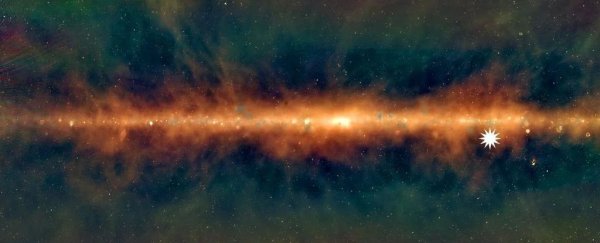A mysterious, repeating radio signal in the Milky Way that baffled astronomers could be an object so rare, only one other has ever been tentatively identified.
According to a paper by astrophysicist Jonathan Katz of Washington University at St. Louis, uploaded to preprint server arXiv, and yet to be peer-reviewed, the signal named GLEAM-X J162759.5−523504.3 could be a white dwarf radio pulsar.
"Since the early days of pulsar astronomy there has been speculation that a rotating magnetic white dwarf might show pulsar-like activity," Katz wrote in his paper.
"The recently discovered periodic radio transient GLEAM-X J162759.5−523504.3 is a candidate for the first true white dwarf pulsar. It has a period of 18.18 minutes (1091 s) and its pulses show low frequency (72–215 MHz) emission with a brightness temperature ∼ 1016 K implying coherent emission. It has no binary companion with which to interact. It thus meets the criteria of a classical pulsar, although its period is hundreds of times longer than any of theirs."
When a star dies, there are a range of outcomes, once it has ejected its outer material and core, no longer supported by the outward pressure of fusion, it collapses under its own gravity.
If the precursor star is over around 30 times the mass of the Sun, the core collapses into a black hole.
A precursor star between eight and 30 times the mass of the Sun results in a neutron star, around 20 kilometers (12 miles) across and up to around 1.4 times the mass of the Sun.
The core of a precursor star less than eight times the mass of the Sun will collapse into a white dwarf, packing mass up to 1.5 times that of the Sun into a ball between the sizes of Earth and the Moon.
Pulsars are a subset of neutron stars. They're neutron stars that rotate insanely fast, and angled in such a way that beams of bright radio waves shooting from the magnetic poles sweep past Earth on every rotation – on the scale of seconds down to milliseconds. (Here's what that sounds like transcribed into audio.)
Scientists have wondered if similar behavior might be observed in white dwarf stars, and in 2016, they seem to have come close, with a star called AR Scorpii. Locked in a binary system with a red dwarf star, AR Scorpii flashes on a timescale of minutes.
However, as Katz notes, its binary orbit is closer than those of neutron star pulsars in binary systems, and the periodic signal lacks coherence. This means that the physical processes that produces the signal might be very different from traditional radio pulsars.
This brings us back to GLEAM-X J162759.5−523504.3, located roughly 4,000 light-years away from Earth. From January to March of 2018, data collected by the Murchison Widefield Array in the Australian desert showed it pulsing brightly for roughly 30 to 60 seconds, every 18.18 minutes – one of the most luminous objects in the low-frequency radio sky.
It matched the profile of no known astronomical object, but the research team that discovered it thought it might be a hypothetical object known as an ultra-long-period magnetar. That's a neutron star with an extraordinarily powerful magnetic field, but the explanation still didn't quite fit.
"Nobody expected to directly detect one like this because we didn't expect them to be so bright," astrophysicist Natasha Hurley-Walker of the Curtin University node of the International Centre for Radio Astronomy Research (ICRAR) in Australia explained at the time. "Somehow it's converting magnetic energy to radio waves much more effectively than anything we've seen before."
A pulsar was considered as a possibility, but there are two major problems: the first is that long rotation period, and the second is that the pulses were too bright for a neutron star pulsar. Both these problems, Katz lays out, are resolved if the object is a white dwarf.
If this is the case, it would be the first white dwarf discovered that shares the physics and radiation mechanism of traditional radio pulsars. This means that GLEAM-X J162759.5−523504.3 could be a promising target for optical observations; although white dwarfs are very dim, and we might not be able to pick up any visible light at its distance. Nevertheless, given the possibility, it's worth a shot.
And astronomers could also examine other white dwarfs, to see if they match any of the properties of GLEAM-X J162759.5−523504.3.
"If it were bright enough, optical observations could also determine its magnetic field, spectroscopically or polarimetrically," Katz explained.
"The fast-rotating, strongly magnetized, white dwarves would be promising targets for low frequency radio observations to determine if any of them are white dwarf pulsars."
The paper has been uploaded to preprint server arXiv.
